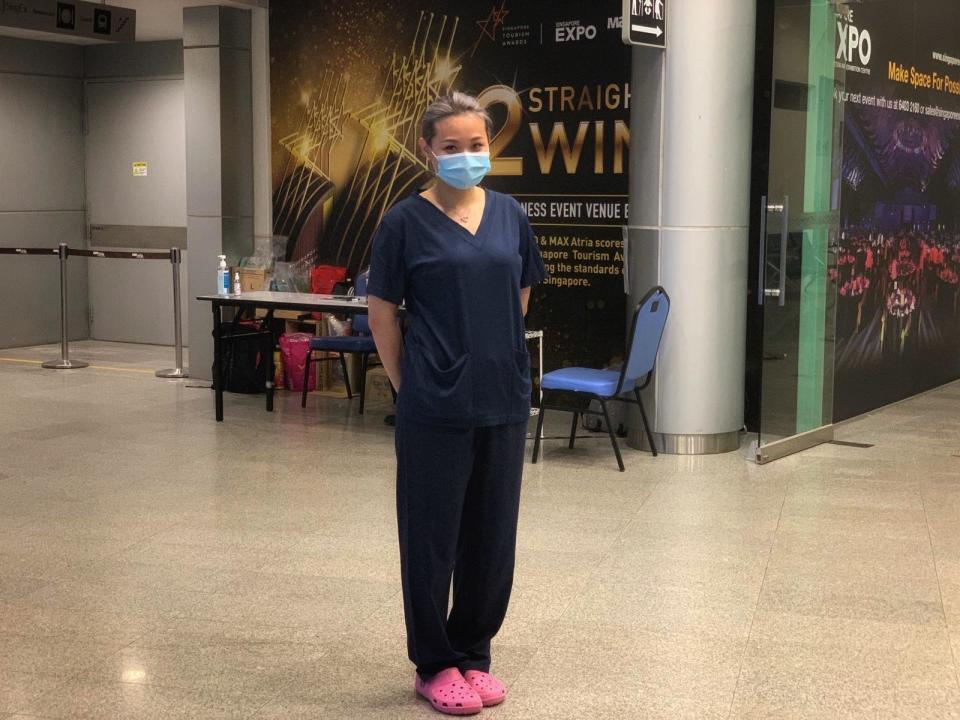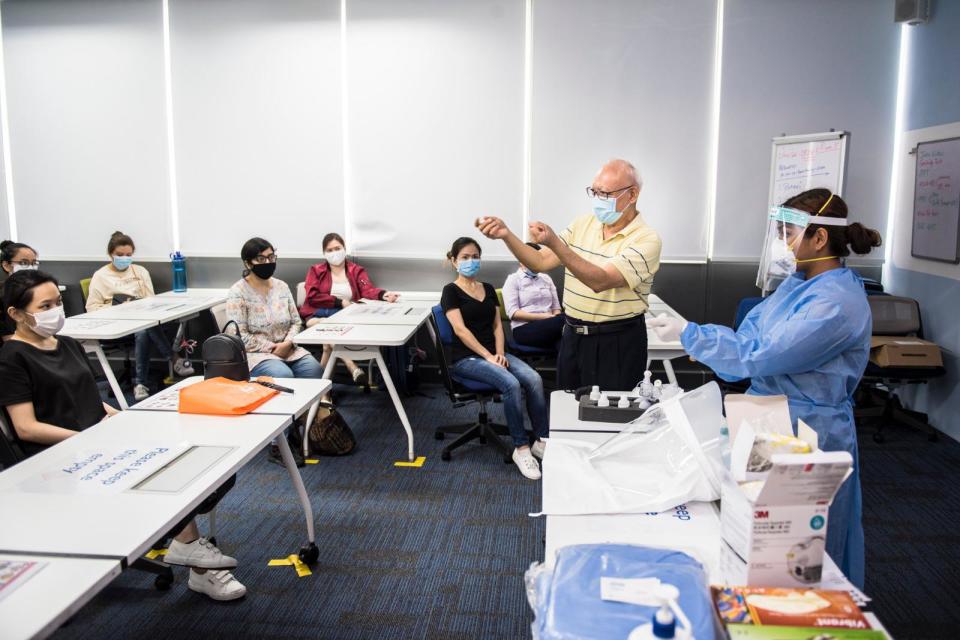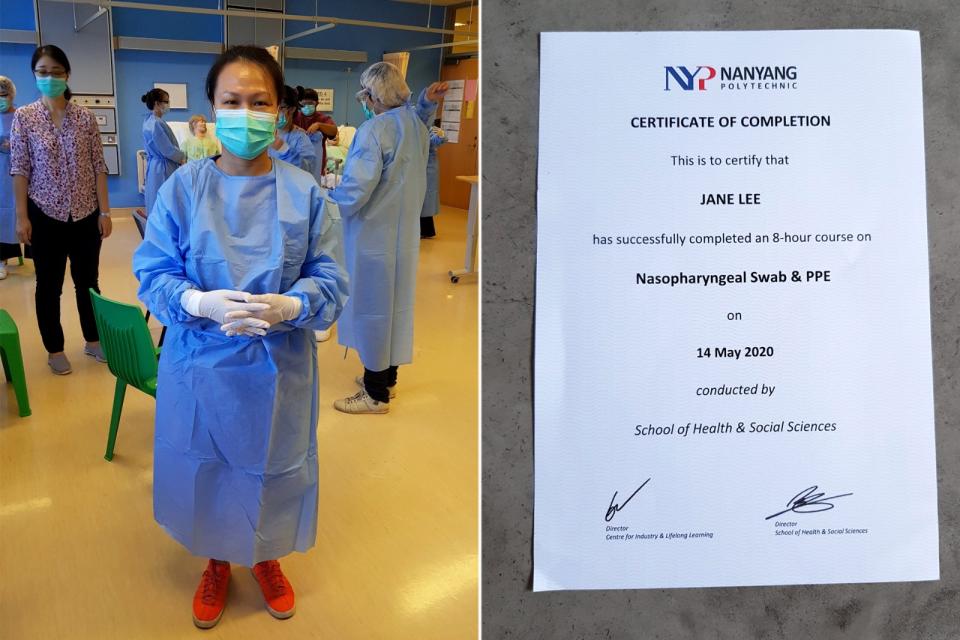Protective gear and boogers: COVID-19 healthcare volunteers share tough, interesting stories

SINGAPORE — What do you do if a swab sample from someone’s nose has a booger on it?
“Somebody in my group was like ‘Erm, flick it away? And my instructor went ‘what?’” recalled Ms Jane Lee, a certified volunteer swabber.
The 43-year-old recently underwent a full-day training course where participants learned how to swab a person using three different methods, the protocols guiding the swabbing and how to put on protective gear.
Lee, the founder of content marketing agency Lede Collective, took Yahoo News Singapore through her training at Nanyang Polytechnic, which included practising to take a swab sample from the life-sized head of a mannequin.
While the training session had its light-hearted moments, other aspects of volunteering have placed volunteers under challenging circumstances.
Another volunteer found himself donning several layers of protective gear in sweltering conditions while taking swabs from patients, while another faces 12-hour shifts caring for patients at the community care facility in Singapore Expo, which was set up as a temporary isolation facility to house migrant workers in April.
Of the four healthcare volunteers who shared their stories with Yahoo News Singapore, three are under the SG Healthcare Corps Scheme, while one – a dentist – volunteered as part of a company-led effort. The SG Healthcare Corps Scheme, which calls for experienced healthcare workers as well as inexperienced members of the public, began on 7 April and has seen more than 16,500 sign-ups since.
Of these, 6,200 are healthcare professionals, such as doctors, dentists and oral health therapists, and support care staff. The remaining participants do not have experience in the healthcare industry and ranged from retirees to fresh graduates. The scheme matches participants to suitable opportunities.
Singapore has seen more than 40,600 cases of COVID-19, with a majority of these coming from foreign workers living in dormitories.
12-hour shifts at Singapore Expo
One volunteer who helps take care of affected migrant workers is 32-year-old Joy Tan Xiang Zhou, a cruise ship nurse who had to stop work since the virus hit. She chose not to stay at home.

“As a trained nurse, I prefer to look after patients than to remain at home to rest during this time. When the COVID-19 situation in Singapore escalated, I felt that I could contribute and give back to society at the same time,” said Tan through an email interview.
She volunteers in 12-hour shifts four days a week, looking after patients with mild or no symptoms at the community care facility at Singapore Expo. As part of her volunteer work, Tan also teaches patients to measure their blood pressure and temperature, and input the data into a laptop for monitoring by healthcare workers.
Although worried that her family might be infected through her, Tan said that she would shower once right after her 12-hour shift and again upon she reaching home.
“I am vigilant on the safety precautions. Besides the constant reminders from our seniors, we also look out for and remind one another on the PPE (personal protective equipment) and other safety guidelines,” said Tan, adding that volunteers were also required to check their temperatures twice daily and to remain at home if they were unwell.
“My mother was very worried at first. But she accepted my decision after listening to my explanations and assurances that I would protect myself,” said Tan.
From SARS to COVID-19
A fellow nurse who immediately responded to the call for help was Herbert Phoon Yew Chong, a retiree who now trains other volunteers in putting on their PPE. The 66-year-old’s nursing career spans more than 40 years, including through the Severe Acute Respiratory Syndrome (SARS) period in 2003.

Speaking to Yahoo News Singapore via a conference call, Phoon said that the SARS phase gave him valuable learning points, including how safety and precaution must be maintained.
“It is not a one-time measure that we should only think of when we have a pandemic... So I always emphasise to the trainees... that after this period, we still need to maintain (these measures).”
Phoon’s training sessions span four hours and involves 10 to 20 students who are usually young adults who have little experience in the medical industry, who would go through a practical session to be ‘certified’.
While the government has been encouraging the elderly to stay at home, Phoon noted that he was not working at the frontline. Phoon, who retired between sometimes between 2014 and 2015, said, “As long as we keep to the essentials of safety and take precautions, the risk is lower – much lower – than if we do not keep (to them).
“I still have the breath and the strength to go on and to serve the community. I don’t want to, as what people say retirees do, just sit back,” he added. He had been volunteering at day care centres and providing para-counselling, even before COVID-19 came about.
Phoon, who has no children, said that his wife is supportive of his efforts. “She knows the risk that I have been facing, but we have been through the SARS period... so she is not that worried.”
Sweltering heat in three layers of cloth, gear
Another volunteer who stressed that transmission could be “close to nil” with the right precautions was Dr Terry Teo, a dentist who swabbed migrant workers in dormitories in April.

Dr Teo volunteered with his company, Q&M Dental Group, after the group’s chief executive officer approached the Ministry of Health to offer the services of its staff to swab migrant workers. The company then sourced for protective equipment and conducted in-house training for volunteers such as Teo.
While Teo feared contracting COVID-19, especially with its potentially fatal consequences as he has severe asthma, he said dentists practice what they term “universal precaution” in their work. He stressed that no cases had arisen in his volunteer groups or dental clinics.
The company had also taken extra precaution by having its staff don two layers of protective gear over their own clothes. However, this came with its own challenges as the swabbing work was at times under the sun, with a fan blowing away from everyone.
“Wearing full personal protective equipment under such conditions, your goggles will fog up, you will be extremely hot and dehydrated, and by the time you can remove everything after finishing your allocated number of patients (about 30 or 60), you are literally drenched in sweat and your clothes can be dripping wet,” said Teo, adding that rest, hydration and general health and fitness was of utmost importance.
Another challenge was in communicating with migrant workers who did not speak English.
“It was extremely difficult under such circumstances to explain what the process would be like, which resulted in a few even pulling back in fear or using their hands to push the swab sticks away during the swabbing process,” said Teo.
However, Teo’s skill as a paediatric dentist aided him as he managed to calm them down with his tone of voice to perform a good swab. Being familiar with the region to swab also helped him do the work fast.
“It was really the best use of our skills as dentists during this time of national crisis, where the medical doctors and nurses were stretched treating the positive cases elsewhere. Practiced hands also meant easy and painless swabbing.”
What to do with that booger
For Lee, who has yet to be deployed as a volunteer swabber, volunteering had been a way of helping beyond doing charitable acts such as donations.
Lee underwent a full day of training at Nanyang Polytechnic on 14 May which included a swabbing practice session, a lecture about patient-handling and controlling the infection, how to don safety gear, and a mask-fitting session.

So far, Lee has only tried her hand at swabbing mannequins. Her class of about 14 volunteers was made to practice obtaining a sample through a nasopharyngeal swab, which involves sticking a long plastic swab deep into a person’s nostril to obtain the nasal secretions from the back of the nose and throat.
Said Lee, “I think for most of us, we’re not used to poking things into people’s noses.” She added that some of her classmates’ hands “shook a lot”.
“I think they were quite nervous, but the lecturer was very good. She gave us a tip, saying, ‘you just tell the person to close their eyes, so they cannot see you shaking as well’.”
She recalled a comic moment during practice when “someone pushed (the swab) in so deep, and the instructor went, ‘You went into his brain’.” Such scenarios are unlikely to happen – patients who have had head injuries or surgeries before could have a thinner barrier between the nasopharyngeal and brainstem. Volunteers were taught to ask for patients’ medical history beforehand to prevent such situations.
The class was also taught how to react if a patient they were swabbing sneezes.
“Some people asked if they should just stand in front of the person and show concern, (and the lecturers said)... ‘No, you have to stand as far away as you can’,” said Lee. She also learned to ask the patient to blow their nose first.
But what if you still get a booger on a patient’s swab?
Said Lee, “You close one eye because you can’t really remove it.”
Stay in the know on-the-go: Join Yahoo Singapore's Telegram channel at http://t.me/YahooSingapore



